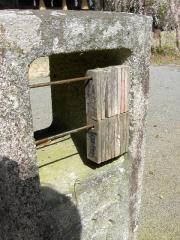|
OTHER STONE MARKERS & MEMORIALS
Last Update: Feb. 22, 2006
Added Omokaru Jizo & Omokaru Ishi
THIS IS A SIDE PAGE
RETURN TO “STONES TOP MENU”
O-HYAKUDO MAIRI
100 Pilgrimages at One Shrine
お百度参り (おひゃくどまいり)
Also called hyakudomairi (hundred pilgrimages) and sengori (thousand purifications). Individual or group practice of traveling back and forth one hundred times between a shrine and some fixed place in that shrine’s precincts, praying each time. Often performed to gain divine aid in cases of sickness and disaster. <source: Online Shinto dictionary of the Institute for Japanese Culture and Classics, Kokugakuin University at www2.kokugakuin.ac.jp/ijcc/wp/bts/bts_o.html#o-hyakudo>
At Zentsūji Temple 善通寺 (Kagawa, Japan)
kagawa.bine.jp/pblog/article.php?id=125
You turn the wheel and make a prayer on
each of the 100 circuits in your pilgrimage.
Photo Tour of Hyakudo Mairi Stones
http://kagawa.bine.jp/jinnjya/topix/100do/100do.html

See the wooden slabs in above photo.
You push aside one each time you reach the stone,
until they are all on the other side, completing your 100 walks.
Courtesy of http://kagawa.bine.jp/jinnjya/topix/100do/100do.html
There are variants. In some shrines, when you turn the wheel, you have to make sure nobody sees you, otherwise your wish will not come true. Therefore this pilgrimage is usually practiced in the dark of the night. <source tctv.ne.jp/tobifudo/HandS/tango/hyakudo/hyakudo.html>
There is a Japanese Buddhist variant of the Hyakudo Mairi Shinto tradition that involves the beloved Jizo Bosatsu. It is called the 地蔵車. This translates as the Jizo Wheel (which includes the afterlife wheel, 後生車, ごしょうぐるま) and the Bosatsu wheel (菩提車, ぼだいぐるま). Found in front of many temples. When you say your wish while turning the wheel downward, a wish for the afterlife will be granted. When you turn the wheel upward, a wish for your present life will be granted. For details, please see: www.fmkagawa.co.jp/yomu/88/88-56.htm.
Photo courtesy www.fmkagawa.co.jp/yomu/88/88-56.htm
Jizo Wheel at Dazaifu
Courtesy of www.jomon.ne.jp/~oldpine/photo4.html
For more, please see Japanese language site at:
http://homepage3.nifty.com/yukijuku/karafune/k35.htm
Haiku Monument Stones
Literature Stones, Memorial Stones
Under construction.
Please visit below site for many examples.
www.lib.ehime-u.ac.jp/KUHI/ENG/kuhisakuineng.html
Omokaru Jizo
At Gokurakuji Temple
2nd Site of Shikoku Pilgrimage
Also called:
Jizo to hold in your arms
Photo courtesy this J-Site |
|
Omokaru Ishi
おもかる石
Omokaru Jizo
おもかる地蔵尊
Below text courtesy Gabi Greve.
Omokaru-ishi literally means “heavy or light stones.” There are numerous variations for these types of stones and statues.
Essentially, you make a wish and try to lift the stone (or statue). If you can carry it (karui = light), your wish will be granted. If you cannot carry it (omoi = heavy), then you have to come back another day and try again. Sometimes a statue of Jizo Bosatsu is used instead of a stone. For more details and a list of sites where these stones are located, please see this web page by Gabi Greve.
THIS IS A SIDE PAGE
RETURN TO “STONES TOP MENU”
|